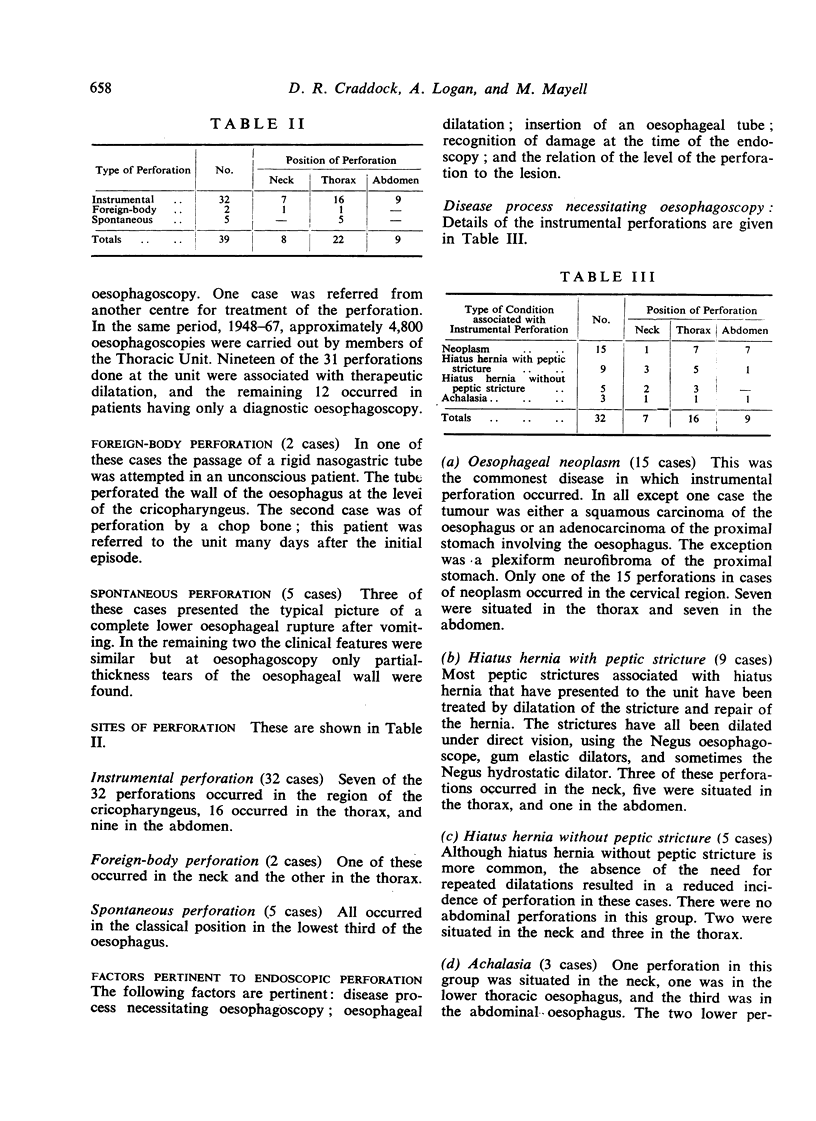Abstract
Thirty-nine cases of traumatic perforation of the oesophagus or stomach have been studied. Thirty-two of the perforations followed oesphagoscopy, five were `spontaneous,' and two were due to damage by a foreign body. Eight of the perforations occurred in the cervical oesophagus, 22 in the thoracic portion, and nine were in either the abdominal oesophagus or the stomach. Treatment was of two types—either operative closure of the perforation or a conservative routine of intravenous fluids, parenteral antibiotics, and cessation of oral feeding. In some patients treated conservatively, drainage procedures were also carried out. Five patients with terminal carcinoma, in whom oesophageal intubation after prolonged dysphagia caused perforation, had no treatment apart from analgesics and sedatives. Several of the patients treated by surgical closure had a concurrent definitive operation (resection of carcinoma in four cases and myotomy for achalasia in two cases). Fourteen of the 21 patients treated by repair or resection of the perforation survived. Ten of the 13 treated conservatively also survived. The good results of conservative treatment for cervical perforations appear to make it the treatment of choice. Only an occasional case of thoracic perforation is suitable for conservative treatment, and as a general rule perforations in this area and in the peritoneal cavity should be treated surgically.
Full text
PDF





Selected References
These references are in PubMed. This may not be the complete list of references from this article.
- ATKINSON M., BOTTRILL M. B., EDWARDS A. T., MITCHELL W. M., PEET B. G., WILLIAMS R. E. Mucosal tears at the oesophagogastric junction (the Mallory-Weiss syndrome). Gut. 1961 Mar;2:1–11. doi: 10.1136/gut.2.1.1. [DOI] [PMC free article] [PubMed] [Google Scholar]
- BILL A. H., Jr, MEBUST W. K., SAUVAGELR Evaluation of techniques of esophageal dilation in relation to the danger of perforation. A study of 441 dilatations of benign strictures in children. J Thorac Cardiovasc Surg. 1963 Apr;45:510–514. [PubMed] [Google Scholar]
- CLARK D. H., TANKEL H. I. PRESSURE RUPTURE AND SPONTANEOUS PERFORATION OF THE OESOPHAGUS. Gut. 1964 Feb;5:86–89. doi: 10.1136/gut.5.1.86. [DOI] [PMC free article] [PubMed] [Google Scholar]
- Froggatt D. L., Gunning A. J. Treatment of oesophageal perforation. Thorax. 1966 Nov;21(6):524–528. doi: 10.1136/thx.21.6.524. [DOI] [PMC free article] [PubMed] [Google Scholar]
- HUGH T. B. SPONTANEOUS RUPTURE OF THE OESOPHAGUS. Br J Surg. 1965 Jan;52:73–75. doi: 10.1002/bjs.1800520116. [DOI] [PubMed] [Google Scholar]
- KERR I. H. A method of demonstrating the site of a perforation of the oesophagus. Br J Radiol. 1962 Apr;35:255–260. doi: 10.1259/0007-1285-35-412-255. [DOI] [PubMed] [Google Scholar]
- NEALON T. F., Jr, TEMPLETON J. Y., 3rd, CUDDY V. D., GIBBON J. H., Jr Instrumental perforation of the esophagus. J Thorac Cardiovasc Surg. 1961 Jan;41:75–104. [PubMed] [Google Scholar]
- NELSON R. E. Traumatic rupture of the esophagus. J Thorac Surg. 1959 Feb;37(2):220–223. [PubMed] [Google Scholar]


